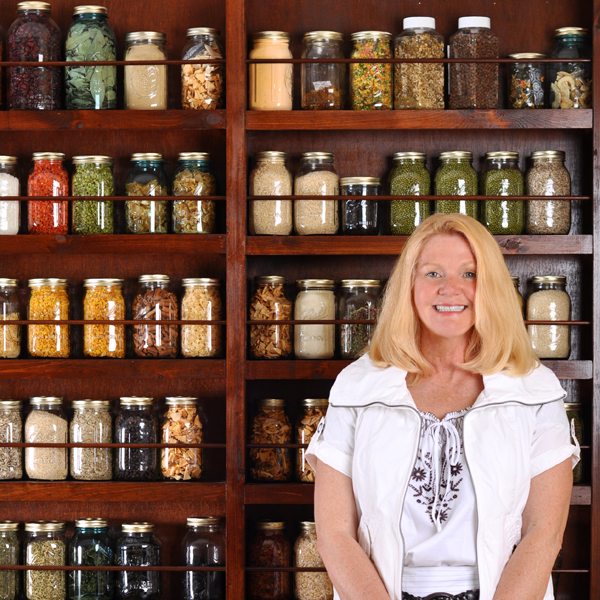Home » How to Build Canning Shelves
How to Build Canning Mason Jar Shelves
Learn how to build canning shelves for your home! These beautiful, cost-friendly, and easy-to-build shelves will add form and function to your home! A gorgeous place to store all the beautiful Mason jars of dehydrated and canned foods that you use on a day-to-day basis. Watch our video, and use the easy-to-follow instructions!
The finished shelving unit measures 25″ wide, 8″ deep, and 8′ high, and cost a total of $70.00 to build, including the stain!
Parts and Materials
- Five 1″ x 6″ x 8′ boards (in the video we bought eight boards, but only needed five)
- Six 1″ x 2″ x 8′ boards
- One 1/4″ x 4′ x 8′ luan board (cut to 2′ 1″ width)
- Eight 3/8″ x 48″ poplar dowels
- One 11/16″ x 1/2″ x 10′ board
- Red mahogany stain
- Tung oil or wipe-on polyurethane
Tools you will Need
- Electric hand drill
- 2 Saw horses
- Staining rag / wash rag
- Air gun or other nail gun
- Miter saw
- Four or more clamps, 8-inch or larger
- Straight edge or square with ruler
- Flush cut saw/knife
- Wood filler/putty
- Wood glue
- Nail gun nails
- Stud finder
- Drywall screws with anchors (if no stud) or wood screws (if stud) (to attach furring strip to wall)
Assembly Instructions
Part 1: Inner Frame
- Stain all of the wood with one coat of red mahogany stain.
- Clamp the two 1″ x 6″ x 8′ boards together so they are completely flush.
- Choose one side to be your base. Measure 5″ up from that side and draw a line.
- From this first line measure 10″ up and draw 7 more lines each 10″ apart. This will give you a total of seven small shelf spaces and one large shelf space.
- Draw a small circle 3 inches up (away from the base) from each line. Make sure the circles are about 1/4 inch from the edge of the boards. You will have 8 circles.
- Use a hand drill to drill through each circle.
- Cut the 1/2″ x 3/4″ x 10′ board into sixteen 5 and 1/2 inch segments, these are your cleats.
- Lay the 1″ x 6″ x 8′ boards flat next to each other making sure the drilled holes are both facing inward (if each hole is 1/4 inch from the edge, the holes will be 1/2 inch from each other).
- Clamp the boards together.
- Extend all of the lines you drew on the first board across the second as well.
- Lay the 5.5-inch cleats onto the lines you drew on your boards. Make sure the cleats are on the underside of the line, i.e. the pencil line is further from the base than the cleat.
- Position the cleats so they touch in the middle of the boards. Do not worry about extra space on the edges of the board, the cleats are not supposed to be the size of the board.
- Use a nail gun to fasten the cleats to the boards.
- Cut your other 1″ x 6″ x 8′ boards into eight 2-foot sections. These will be your shelves.
- Cut two 25.5 inch segments out of your 1″ x 6″ x 8′ board. This is your base and top.
- Position the boards with the cleats onto their sides with the cleats facing inwards.
- Nail the baseboard onto the SIDE of the cleat boards, and the top board onto the TOP of the cleat boards. (See video above)
- Your shelving unit should now be sturdy enough to freely balance when turned onto its side.Place your shelving unit onto its side and straddle on top of it to apply a small amount of pressure.
- Insert each 2′ shelf on top of the cleats (away from the base board).
- Use a nail gun to drive nails through the side boards into the shelf boards.
Part 2: Outer Frame
- On the “back” of the shelves (the side opposite from the base board) nail your luan ply board (first put one nail into each corner and then put several nails along the edges).
- Cut 6 inches off of two of your 1″ x 2″ x 8″ boards (So, now they are 1″ x 2″ x 7’6″ boards) and nail these boards onto the front of your shelves. These are the sides of your frame. Make sure they are flush with the edges.
- Cut your other 1″ x 2″ x 8′ boards into eight 22.5″ segments. Nail seven of these boards onto the sides of your shelf boards as the frame, and one of these boards onto the side of your top board as the frame. Make sure the frame is flush with the TOP of each shelf.
- Insert wooden dowels through each hole so that one end is completely flush. Place a small amount of wood glue to secure. Use your flush cut knife to saw off the excess dowel leaving two flush ends.
- Use wood putty to fill any unsightly nicks or indents left from nail holes, then apply another thorough coat of stain.
- Allow to dry, coat with Tung oil, and fasten to the wall.
Fastening to the Wall
- Place your shelving unit against the wall to which you intend to fasten.
- If there is shoe molding, mark it with a pencil, remove, cut, and then reattach, to make room for the shelf to be flush with the wall.
- If you have trim around the bottom of your wall, use a scrap piece of wood as a furring strip between your shelf and the wall to separate them. Screw the furring strip anywhere on the wall where your shelf will be.
- You will use your extra 1″ x 2″ x 8′ strips as a frame to cover the gap between your shelves and the wall created from your wall trim and furring strip.
- Measure the size of your trim and cut the side strips accordingly to fit around the trim (see video above).
- Screw the shelving unit to the furring strip.
- Nail the side trim pieces around the shelving unit creating a frame.
- Cut another 1″ x 2″ x 8′ strip to approximately 27 inches and nail it to the top of the shelving unit to complete the frame.
- Fill shelves with jars of dehydrated and canned foods and enjoy!

